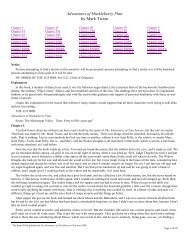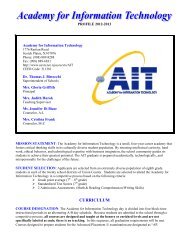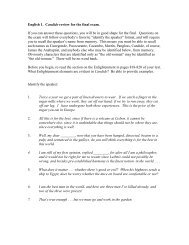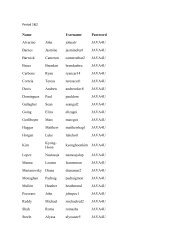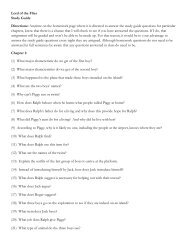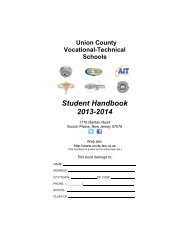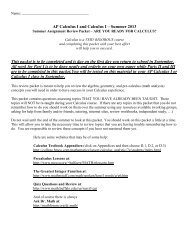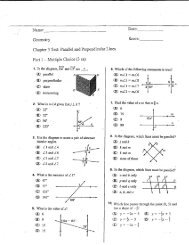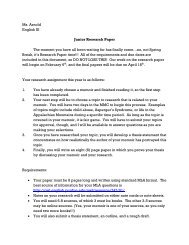AP US History Summer Assignment
AP US History Summer Assignment
AP US History Summer Assignment
You also want an ePaper? Increase the reach of your titles
YUMPU automatically turns print PDFs into web optimized ePapers that Google loves.
Advanced Placement United States <strong>History</strong> <strong>Summer</strong> <strong>Assignment</strong>s<br />
1. Pick up your textbook by June 15 at Bistocchi Hall.<br />
2. <strong>Summer</strong> reading:<br />
MAYFLOWER: Story of Courage, Community, and War.<br />
By Nathaniel Philbrick.<br />
Illustrated. 461 pp. Viking.<br />
The book is easily obtained through any book retailer, new or used, or at your local library. It's a<br />
great read. I have one spare copy.<br />
3. Write a 4-page, MLA-style paper on the following topic:<br />
Compare and contrast the relationship between the Plymouth settlers and the Native<br />
Americans. Why did the Pilgrims survive and why did the Native Americans languish?<br />
Think about:<br />
Details about the Pilgrims’ early survival.<br />
Religion<br />
Disease<br />
Land ownership<br />
Racism<br />
The Pequot War<br />
King Philip’s War<br />
Writing rules: In the body of a paper or essay [including free response questions (FRQ)<br />
and document-based questions (DBQ)] for <strong>AP</strong> United States <strong>History</strong> class:<br />
Include a thesis paragraph<br />
Defend your thesis<br />
Use adjectives sparingly<br />
Watch verb tenses<br />
Never use first person<br />
Never ask a question<br />
Employ proper grammar<br />
Avoid colloquialisms<br />
Citations: To cite a book in the body of an essay (non-DBQ or FRQ) use the author’s<br />
name and the page number. If the book has more than one author, use the last name of the<br />
first author:<br />
• (Philbrick, 271),<br />
• (Horn, 54)<br />
To cite an Internet source, use the URL:<br />
• (http://www.mayflowerhistory.com/<strong>History</strong>/mflower7.php)
In the body of a document-based question essay (DBQ), cite the document<br />
number:<br />
• (Document 1)<br />
4. Read Chapter 3 in Out of Many.<br />
5. Do the Document-based question (DBQ) at the end of the chapter. DBQs require<br />
students to read the documents and answer the question in essay form.<br />
6. Take the practice quiz below:<br />
Quiz, Chapter 3, Planting Colonies of North America<br />
MULTIPLE CHOICE. Circle the one alternative that best completes the statement or answers the question. If<br />
submitting via email, bold-face your response<br />
1. The Pueblo Revolt of 1680:<br />
A. resulted from the governors ignoring the Catholic priests' advice.<br />
B. led to Spain's withdrawal from New Mexico for 100 years.<br />
C. resulted in the surrender of the Pueblos in the autumn of 1680.<br />
D. was a response to the Franciscan demand that the Indians totally reject their traditional culture.<br />
E. occurred because the Pueblos rejected everything Spanish.<br />
2. The leader of the Pueblo Revolt of 1680 was:<br />
A. Tecumseh.<br />
B. Opechancanough.<br />
C. Popaccente<br />
D. Vargas.<br />
E. Hopi.<br />
3. The population of New France grew slowly because:<br />
A. the government restricted Catholics and the Huguenots refused to go.<br />
B. Catholics were not allowed to enter New France; rather, it was used as a place of exile for Huguenots.<br />
C. the government placed high taxes on all income acquired in New France.<br />
D. weather conditions in New France were much less favorable than those in France.<br />
E. transportation costs to New France were overwhelmingly expensive and conditions were unsafe.<br />
4. By 1700, New France had a population of:<br />
A. 5,000.<br />
B. 10,000.<br />
C. 15,000.<br />
D. 25,000.<br />
E. 35,000.<br />
5. The Netherlands was able to establish a colony in the Americas for all of the following reasons EXCEPT:<br />
A. it formed an alliance with the Iroquois to obtain furs.<br />
B. it developed a prosperous urban society with the first modern investment banks.<br />
C. it had a strong navy and a number of trading posts around the world.<br />
D. it had superior products of metal tools and firearms used for profitable trade.<br />
E. it had a large population that was eager to settle colonies.<br />
6. The person responsible for the Dutch claim to land in North America was:<br />
A. John Cabot.<br />
B. William Breuker.<br />
C. Samuel de Champlain.<br />
D. James Vandenberg.<br />
E. Henry Hudson.<br />
7. The Indian name of the Algonquian chief in the Chesapeake was:<br />
A. Wahunsonacook<br />
B. Powhatan.<br />
C. Popé.<br />
D. Tecumseh.<br />
E. Opechancanough.
8. The political system of the Algonquian people in the Chesapeake was known as the:<br />
A. Powhatan League.<br />
B. Algonquian League.<br />
C. Wahunsonacook League.<br />
D. Powhatan Confederacy.<br />
E. Wahunsonacook Confederacy.<br />
9. When the English established Jamestown without much Indian opposition, it showed that the:<br />
A. Algonquians of the Chesapeake had no government or organization.<br />
B. Algonquian people had no experience with Europeans.<br />
C. Indians were too weak to stop them.<br />
D. Algonquian trusted the English and hoped to learn from their culture.<br />
E. Indians sought to use the Europeans to realize their own goals.<br />
10. The Virginia Company, which founded Jamestown in 1607, was a particular kind of company called a(n):<br />
A. Joint-stock company.<br />
B. Tenure colony.<br />
C. Proprietary colony.<br />
D. Royal colony.<br />
E. Headright company.<br />
11. The results of Jamestown adopting tobacco as its chief product included all of the following EXCEPT:<br />
A. the demand for more land as the society became agricultural.<br />
B. the development of a landed elite and a poor underclass.<br />
C. a desire for more trade and better relations with the Indians.<br />
D. a need for workers, which led to more immigration.<br />
E. it provided the Virginia Company with the first returns on its investment.<br />
12. The colony of Maryland was distinctive because:<br />
A. it was the first "proprietary" colony issued by King James II.<br />
B. as a virtual feudal estate, it had no representative institutions.<br />
C. Charles I granted it to the Calverts, who made it a Catholic refuge.<br />
D. it was founded not by a joint-stock company, but by the King.<br />
E. the colonists avoided the example of Virginia and its problems.<br />
13. In 1640, Maryland established a plantation economy based strictly on:<br />
A. feudal grants.<br />
B. indentured servitude.<br />
C. slavery.<br />
D. serfdom.<br />
E. the headright system.<br />
14. Those indentured servants who survived their term in North America:<br />
A. overwhelmingly chose to stay in the colonies, usually near their former master.<br />
B. were overwhelmingly men; more women died of sickness than their male counterparts.<br />
C. received clothing, tools, a gun, or a spinning wheel, and helped getting started on their own.<br />
D. hardly regretted the decision to seek land and opportunity in the Americas.<br />
E. headed south in the hope of cutting a farm from the wilderness.<br />
15. The Puritan migration to New England was promoted when Charles I:<br />
A. married a Lutheran princess.<br />
B. launched a campaign of political oppression on all Protestants.<br />
C. raised taxes on every citizen who was not a Roman Catholic.<br />
D. dismissed Parliament and thereby reduced its members' ability to express their views.<br />
E. supported the "Low Church."<br />
16. The early English settlements in New England:<br />
A. were founded by Captain John Smith before the French captured him.<br />
B. struggled to survive due to harsh battles to reduce the French and Dutch from the Atlantic coast.<br />
C. had to remove the French and Dutch, who had settled there first.<br />
D. benefited from reduced Indian resistance after an epidemic cut the Indian population.<br />
E. became the prosperous farming communities described by John Smith.
17. When the Pilgrims arrived in New England, they encountered:<br />
A. strong resistance by the Dutch colonists.<br />
B. hostile Iroquois Indians.<br />
C. friendly Pokanokets Indians who offered them food and advice.<br />
D. thriving Indian societies along the coast.<br />
E. strong resistance by the French colonists.<br />
18. Those English Protestants who believed that the Church of England was too corrupt to be saved were called:<br />
A. Anglicans.<br />
B. Puritans.<br />
C. Separatists.<br />
D. Baptists.<br />
E. Methodists.<br />
19. The colony of Plymouth:<br />
A. established a strict religious doctrine according to Puritan ideas.<br />
B. survived despite fierce Indian opposition in the early years.<br />
C. had a strong communal sense but soon spread, losing communal sense to local interests.<br />
D. suffered in its loyalty to the community, focusing on religion more than obligations to one another.<br />
E. owed little to anyone in England and became an independent society.<br />
20. John Winthrop, the first governor of Massachusetts Bay, advocated building a model society that would act as<br />
an example for England, and referred to the settlement as:<br />
A. "the Enlightenment."<br />
B. "an American Reformation."<br />
C. "a perfect society."<br />
D. "heaven on earth."<br />
E. "a city on a hill."<br />
21. The Puritans interacted with the Algonquian peoples by:<br />
A. treating them all with Christian charity as fellow human beings.<br />
B. recognizing that Indians had rights to the land even though they used it differently.<br />
C. noting that God removed them by disease and Scripture justified their destruction.<br />
D. negotiating high, but fair, prices for the land the Puritans successfully acquired.<br />
E. relying strictly on negotiated treaties in order to acquire more land.<br />
22. The Puritans were able to establish many new towns in the 1630s because of all of the following EXCEPT:<br />
A. the argument that the Indians were not using the land as God intended.<br />
B. demands for Indian payment in land as punishment for violating English law.<br />
C. attacks on French settlements and incorporation of those lands.<br />
D. a smallpox epidemic that left many abandoned villages.<br />
E. illegal treaties and deals with dishonest sachems.<br />
23. The community life of the Puritans was characterized by all of the following EXCEPT:<br />
A. a strict moral code that suppressed any mention of sexuality, even in marriage.<br />
B. a belief in a social hierarchy ordained by God.<br />
C. a high degree of discipline, discipline, and respect within the families and community.<br />
D. towns centered on churches and schools rather than on individual plantations.<br />
E. subordination of women to men and suspicion of independent women.<br />
24. The most tragic of the witchcraft scares in New England occurred in 1692 in:<br />
A. Plymouth.<br />
B. Salem.<br />
C. Boston.<br />
D. Providence.<br />
E. Wilmington.<br />
25. The principal founder of Rhode Island was:<br />
A. Anne Hutchinson.<br />
B. Thomas Hooker.<br />
C. Cotton Mather.<br />
D. William Bradford.<br />
E. Roger Williams.
26. Colonies that the king granted to individuals, who then had total control over them, were known as:<br />
A. colonial colonies.<br />
B. tenure colonies.<br />
C. proprietary colonies.<br />
D. joint-stock colonies.<br />
E. royal colonies.<br />
27. New Netherland became New York as a result of:<br />
A. the Dutch colonists' revolt over the colony due to the harsh restrictions on religious freedoms.<br />
B. the competition and series of wars between England and Holland after 1650.<br />
C. the splitting off of settlements in the Delaware Valley, which weakened New Netherland.<br />
D. the Dutch ceding it to England after the Dutch West Indies Company failed.<br />
E. Dutch inability to control the diverse population of the colony.<br />
28. William Penn wanted Pennsylvania to be a:<br />
A. "sacred land."<br />
B. “holy experiment."<br />
C. "righteous pathway."<br />
D. "safe haven of freedom."<br />
E. "colony of friends."<br />
EXTRA Credit (3 Points)<br />
29. The correct chronological order of the beginning dates of the following wars is:<br />
A. King William's War, King Philip's War, the Glorious Revolution in America, and the Beaver Wars.<br />
B. the Glorious Revolution in America, the Beaver Wars, King William's War, King Philip's War.<br />
C. the Glorious Revolution in America, the Beaver Wars, King Philip's War, and King William's War.<br />
D. King Philip's War, the Glorious Revolution in America, the Beaver Wars, and King William's War.<br />
E. the Beaver Wars, King Philip's War, the Glorious Revolution in America, and King William's War.



